Seacombe |
Irving Theatre
(Kings/La Scala/Hippodrome/Embassy)
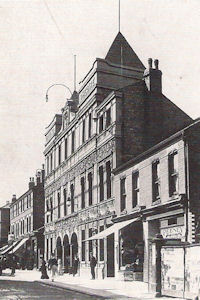 Situated in Victoria Road (later to become Borough Road in 1914) stands a typical ornate Edwardian building - the Irving Theatre. It was built on a site previously occupied by Hope House and its gardens, for Mr. James Kiernan who had a growing empire of theatres. On 11th October 1899 the distinguished actor Sir Henry Irving laid the cornerstone of the building and agreed for his name to be associated with the building for as long as it was used for serious theatre. The grand opening took place on Monday, 18th December 1899 with a performance of 'The Sign Of The Cross' by a cast of over sixty performers. Mr J.H. French became the manager of the theatre.
Situated in Victoria Road (later to become Borough Road in 1914) stands a typical ornate Edwardian building - the Irving Theatre. It was built on a site previously occupied by Hope House and its gardens, for Mr. James Kiernan who had a growing empire of theatres. On 11th October 1899 the distinguished actor Sir Henry Irving laid the cornerstone of the building and agreed for his name to be associated with the building for as long as it was used for serious theatre. The grand opening took place on Monday, 18th December 1899 with a performance of 'The Sign Of The Cross' by a cast of over sixty performers. Mr J.H. French became the manager of the theatre.
Inside the theatre the auditorium consisted of stalls and a steeply stepped horse-shoe shaped balcony that was supported by six pillars. The stage was fully equipped with a fly-tower and at each side of the stage were two tiers of boxes. The theatre could seat over 900 patrons.
In 1904 the theatre went through some refurbishments which included re-flooring the pit, laying linoleum, installing new seats and putting up a draught screen in the stalls. The theatre re-opened in September 1904 with films being shown as the main attraction which was billed as the new wonder of the age. The opening programme on Monday, 12th September, was advertised as "The Rage of Liverpool! Animated Picture World" and featured animated pictures of the Royal Visit to Liverpool and "the greatest collection of living pictures the world has ever produced", including 'Living Wallasey' from day to day incidents taken from real life. Also included were 'Off For The Holidays'. 'Pictures from Lakeland to the Isle of Man' and ''The Miser's Daughter', plus shots of the Russo-Japanese war. The supporting entertainment was provided by Thomas Shaw's Celebrated Orchestra. Seating costs varied with admission charges of Boxes 21/-, 10/- 3/- and 2/6; Orchestra Stalls 2/-; Dress Circle 1/6; Pit Stalls 1/-; Family Circle 1/-; Pit 6d and Gallery 4d. There was one performance at 8.00 pm.
In 1908 a serious fire in the theatre closed the building for several months causing some £2,000 of damage. Music hall programmes were introduced after re-opening but because of the personal agreement with Irving, the theatre had to change its name, this time to the King's Theatre.
In 1912, after a period of closure for extensive re-decoration and renovation, which included the theatre being fitted throughout with tip-up seats and the stage draped with red velvet curtains, the building re-opened on Easter Monday 1912 as the 'La Scala - The Philharmonic Cinema' under the management of Ludwig Blattner. He was responsible for these changes and he also conducted the New Cosmopolitan Orchestra which often played his own compositions including a waltz entitled 'Ladies of Wallasey'. By 1914 the film season was once again followed by a reversion to purely stage shows and there was a new manager at the helm. In 1918 the theatre closed for extensive re-decoration and renovation and re-opened in the same year as the Hippodrome under the management of Mr. F.V. Ross, who was also the manager of the Tivoli Theatre in New Brighton. By the end of the year the Hippodrome changed from cinema to stage shows and remained so throughout most of the 1920s until 1928 when the Gordon Circuit purchased the theatre and spent £1,500 on improvements.
At the start of the following decade business at the Hippodrome declined and in 1932 the theatre closed for most of the year. Under new management, C.W.F. Bruton, the theatre re-opened on Boxing Day but was short lived and the premises closed again in April the following year. Under new ownership in 1934 of Pat Collins and new manager Dick Batchelor, a final attempt was made to make the Hippodrome pay as a theatre. They had the building renovated and re-decorated and introduced a seven-piece orchestra. The venture proved unsuccessful and the final closure as a theatre came on 27th April though plans to re-open in August of that year came to nothing.
On 20th April 1936 the building finally re-opened as the Embassy Luxury Theatre with Harry Buxton as owner, who was also the proprietor of the Picturedrome in Birkenhead, and R.A Morton Martin as manager. At last, cine variety had come to Wallasey and the Mayor of Wallasey, Mr. A.V. Vicory Stoins, performed the opening ceremony. The theatre had been entirely redecorated. In the auditorium there were new seats in the circle The cinema screen was set back on the stage in order that the variety shows could be staged in front of it.
The opening performances featured the film 'The Ghost Goes West, starring Robert Donat (1905-1958) and Jean Parker (1915-2005). On stage were Syd Mack and his Broadcasting Band; the BBC star Maggie Scott (The Singing Mill Girl); Ralphino - The Great Conjuror, and the 12 Alhambra Kiddies billed as The World's Most Talented Juveniles. Entrance charges were 6d, 1/- and 1/3.
Subsequent cine-variety programmes included 'Captain Villers Great Television Show' and weekly Amateur Talent Contents. But despite these attractions the theatre was once again up for sale later in the year. Then North Western Cinemas, proprietors of the Liscard Palace and Liverpool Palais de Luxe (Lime Street), took over and announced that from 26th September 1936 the theatre would be used solely as a cinema.
In September 1937 further changes were made to the Embassy with a new lighting system installed that claimed to be the first of its type in the North of England - the 'Holophane auto-selective system'. Installed on the stage, and in the auditorium, the system enabled three colours to be blended so as to create any of the three colours of the spectrum. Also installed was the latest B.T.H (British Thompson Houston) system which provided high-fidelity sound reproduction. However, by far the most striking changes to the premises, occurred in 1938, when after three month period of closure, the Embassy underwent a radical change both inside and outside. The front of the exterior of the building was given a new image which was achieved by a modern canopy and vitrolite cladding in cream, green and black applied to the lower part of the frontage. Inside the heating and ventilation systems were upgraded. The auditorium had been completely re-constructed. The bottle-necked shaped configuration had given way to a new fan-shaped surround, the ante-proscenium being thrown into prominence by a horizontal grille treatment by the flanking pillars of the proscenium. A more modern ceiling replaced the ornate one which now swept down in a series of curves towards the stage with coves which concealed lighting to illuminate the futuristic painted designs that were a feature of both ceiling and walls. The horse-show balcony with its supporting pillars was also replaced by a large new balcony supported by the side walls of the building.
Under the ownership of the North Western Cinemas, the old Irving Theatre had finally become a commercially viable cinema and was to remain like that, unaltered, until the 1950's. In June 1955 a new wide screen CinemaScope was installed closer to the front of the stage. Unfortunately in 1959 the supervisor of North Western Cinemas, Mr. Hector McQueen, announced the closure of the Embassy (the fifth cinema in Wallasey to close). The cause was attributed to the depression and over twenty members of staff were affected. The final film was 'Sea of Sand' starring Richard Attenborough and John Gregon.
Since its closure the premises have been used for bingo whilst the balcony was used for a short while as a separate nightclub.
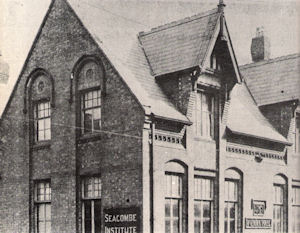 |
Vienna Hall once stood on the corner of Brighton Street and Vienna Street, and opened as a cinema under A.B. Kopetzy in August 1907. The building had originally been a furniture store and was to continue to show films together with variety turns until 1914.
The first advertisement claimed that 30,000 pictures were shown at every performance (which actually referred to the number of picture frames passing through the hand-cranked projector), and also advertised "Songs beautifully illustrated". Programmes were changed every week and were twice nightly at 7.00 and 9.00 pm with matinees every Saturday at 3.00 pm. Admission was 2d, 4d, and 6d, with children half-price.
It was announced in July 1914 that the Vienna Hall would shortly close prior to extensive alterations but by the end of the month it had ceased operation. Shortly afterwards the building was demolished to make way for a completely new cinema, the Marina.
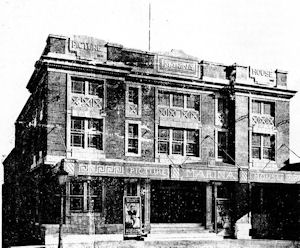 The Marina Super Cinema was situated on Brighton Street and opened by the Mayor of Wallasey Alderman Sidney S. Pawson, on 15th July 1916. The cinema was designed by A. Ernest Shennan of Liverpool on the former site of the Vienna Hall which had closed the year before. The opening feature film was 'The Second Mrs. Tanqueray' starring Sir George Alexander (1858-1918) and Miss Hilda Moore (1890-1929). The music was provided by a 'Symphony Orchestra' comprising two violins, a cello and a double bass under the directions of Alfred Delmonte at the piano. The proceeds of the opening performance were donated to the Mayor's fund. Matinees were daily at 3.00 pm with continuous performances from 6.30 to 10.30 pm. The cinema had seating for 950 and the owners were Bedford Cinemas Ltd., of Liverpool and the manager was Alfred E. Brewer who had previously managed the Palais de Luxe on Lime Street, Liverpool.
The Marina Super Cinema was situated on Brighton Street and opened by the Mayor of Wallasey Alderman Sidney S. Pawson, on 15th July 1916. The cinema was designed by A. Ernest Shennan of Liverpool on the former site of the Vienna Hall which had closed the year before. The opening feature film was 'The Second Mrs. Tanqueray' starring Sir George Alexander (1858-1918) and Miss Hilda Moore (1890-1929). The music was provided by a 'Symphony Orchestra' comprising two violins, a cello and a double bass under the directions of Alfred Delmonte at the piano. The proceeds of the opening performance were donated to the Mayor's fund. Matinees were daily at 3.00 pm with continuous performances from 6.30 to 10.30 pm. The cinema had seating for 950 and the owners were Bedford Cinemas Ltd., of Liverpool and the manager was Alfred E. Brewer who had previously managed the Palais de Luxe on Lime Street, Liverpool.
Architecturally the frontage of the building was attractive with its red-glazed bricks. There was a flight of white marble steps that were surmounted by a large bronze ornamental canopy that lead up to the four entrance doors that had diamond-shaped bevelled glass panels. There was a narrow vestibule with black and white patterned marble floors leading into the red-carpeted entrance hall with its pay-box facing the entrance. The staircase at either side leading to the balcony were also carpeted in red and had a large brass stair rods matching the heavy brass hand rails, door pulls and crash bars. A large multiple bowl Electrolier provided the foyer with lighting.
The auditorium had a lofty ceiling and the panels between the plasterers on the side walls were decorated with dark patterned wallpaper, above which three small rectangular windows were provided immediately below the deep the deep cornice, and there was a dark wood panelled dado. The floor was not very steeply raked and therefore the screen was a considerable height from the floor. The small, but commodious balcony had a concave front and a seating capacity of 220. The main auditorium lighting was provided by a single bowl off-white opaque glass Electroliers suspended on long brass chains from copper chains.
The Marina became a Gaumont-British theatre in 1928 and on 21st April 1930 the British Acoustic Sound Reproducing System had been installed for the Marina's first talkie 'The Sky Hawk'. a Movietone romance with John Garrick (1902-1966), Helen Chandler (1906-1965) and Gilbert Emery (1875-1945). There was no further changes at the Marina until June 1955 when a new wide screen was fitted and in March 1956 the theatre was completely redecorated. However, closure came suddenly on 22nd September 1956 with the last film being 'Reach for the Sky' starring Kenneth Moore (1914-1982). After this the Marina lay derelict until the 1970's when demolition took place to make way for extension to a nearby school.
Poulton |
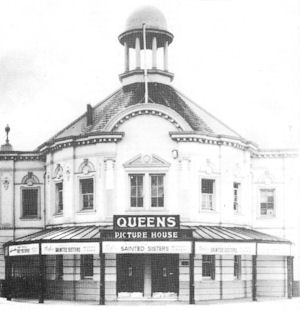 The Queen's Picture House in Poulton Road opened on 4th November, 1911 under the management of Mr. E.F. Evans and was Wallasey's first purpose built cinema. The opening programmes of films ranged from subjects on drama, comedy, travel, education and news. Prices of admission was at 3d, 4d, 6d and 9d and three-hour shows ran from 7.00 pm during the week with matinees at 3.00 pm on Wednesdays. On Saturdays, the programmes was continuous between 6.00 and 10.30 pm.
The Queen's Picture House in Poulton Road opened on 4th November, 1911 under the management of Mr. E.F. Evans and was Wallasey's first purpose built cinema. The opening programmes of films ranged from subjects on drama, comedy, travel, education and news. Prices of admission was at 3d, 4d, 6d and 9d and three-hour shows ran from 7.00 pm during the week with matinees at 3.00 pm on Wednesdays. On Saturdays, the programmes was continuous between 6.00 and 10.30 pm.
The exterior design of the building was particularly attractive with a curved glass verandah encircling the frontage, and the roof was topped with a magnificent dome. The brickwork was covered in a white fibrous plaster which produced a dazzling effect which was enhanced especially at night with some 350 electric light bulbs.
No expense was spared on the interior of the cinema with the lushly carpeted marble entrance, gilt decorations and the crimson plush upholstery on the 800 tip-up seats which had matching thick crimson carpeting in the main hall. The seats were arranged on a sloping floor raked to a height of six feet at the rear. The cinema had no balcony. The screen was painted on the back wall and was surrounded by an arched fibrous plaster frame. An orchestra provided music both to accompany the silent movies as well as providing interludes between films. During the summer there were huge fans which cooled the building and in the colder months a modern heating system provided warmth.
The cinema remained unaltered during the 1920s with only a change in management when Mr. R.P. Rutherford too over and the paramount Orchestra was employed to provide musical entertainment under the baton of Mr. H. Watkinson.
Changes to the Queen's were necessary with the advent of talkies. A new screen was needed to accommodate the sound reproduction equipment. A new proscenium was built which had new royal blue velour drapes and rather unusually, globular light fittings on tripod stands, one either side of the screen. On 12th May 1930 the first talkie was screened with the showing of 'Smiling Irish Eyes' starring Coleen Moore (1899-1988). Also shown was an all-talkie 15 minute short comedy, ''Beach Babes', featuring Charles Kemper (1900-1950) and Evalyn Knapp (1908-1981).
Friday night entertainment from the 30th November 1934 saw the return of the Blue Ribbon Orchestra, which had previously been dispensed with at the end of the silent era. This arrangement continued until the end of the year.
The Queen's retained a regular following during the post-war period right up to the mid 1950s but unfortunately box office takings were beginning to diminish and even though there was an introduction of CinemaScope it failed to reverse its misfortune. The cinema closed its doors on the 18th July 1959 with Frankie Vaughan in 'Lady Is A Square' and 'Gun Battle In Monterey'. This was the seventh cinema to close in the area and the fourth to close in Wallasey that year. Since the closure of the Queen's, the building has been used as a car show room and a supermarket.
Egremont |
Situated in King Street, on the corner of Trafalgar Road, once stool the ecclesiastical building that was once the Lyceum Electric Palace. In 1908 the congregation of the Presbyterian Church of England moved to new premises to Seabank Road. The building remained empty for a couple of years until The Projection Picture Company realised its full potential as a picture house and opened the building as the Lyceum at the beginning of 1910.
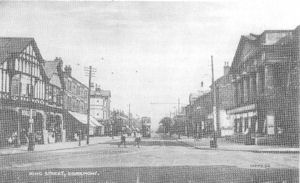 Due to the building once being a church the design of the Lyceum was inspiring. The frontage resembled a Roman Temple with six Tuscan Doric columns supporting an entablature with pediment and tympanum and its stone steps lead up to the main entrance. Covering the width of the entrance was a glazed canopy that was constructed around the columns.
Due to the building once being a church the design of the Lyceum was inspiring. The frontage resembled a Roman Temple with six Tuscan Doric columns supporting an entablature with pediment and tympanum and its stone steps lead up to the main entrance. Covering the width of the entrance was a glazed canopy that was constructed around the columns.
Despite the grandeur of the facade, inside the cinema the church pews were still being used for some time on the ground floor, and because the floor was not raked, it was necessary for the screen to be placed quite high up on the rear wall of the hall to ensure that the audience would have an unimpeded view. Unfortunately all those sitting down at the front would suffer with a stiff neck. At the front of the building at the rear of the balcony was the projection room. One of the earliest films to be shown that was advertised at the Lyceum was 'Watches Of The Night' starring George Nichols (1864-1927) who starred in 221 silent films.
After a short period of closure in 1910 the cinema re-opened later as The Lyceum Electric Palace on August Bank Holiday with much of the interior being reconstructed and redecorated which provided a capacity of 600 patrons in more comfortable surroundings. In the auditorium the supporting columns and the side galleries had been removed. The five deep arched church windows had been bricked in. The opening feature was a film on the local 'Chester Pageant'. Performances were continuous from 6.00 pm til 10.30pm on weekdays and from 2.00 pm on Saturdays and holidays. Admissions was 'Area' 3d and Balcony 6d, with charges for children at 2d and 3d.
By 1911 the theatre was under the management of Matthew Raymond who also conducted the orchestra and provided vocal interludes between the films. There were further improvements made with a ventilation system installed. Also the entrance hall now had a rich red plain carpet and the entrance doors were fully glazed with bevelled glass panels. Inside there was an opaque glass bowl light fitting and the staircases had slim brass stair-rods at either side with bronze balustrades.
The stalls were now slightly raked and the lofty-celinged auditorium had recessed panels along the walls where the deep church windows had formerly been. In front of the stage there was an
orchestra pit and a small platform and hanging from the ceiling were chandelier lights with pink-tinged shades which matched the light fittings on the walls.
The Lyceum (often referred to by patrons as 'The Lyce') changed ownership a number of times over the next few years. In the early 1920s the Bedford Cinema took control and then in 1928 changed hands to the Gaumont-British Picture Corporation. In 1932 plans were announced to replace the theatre with a more palatial building but it came to nothing. In the summer of 1930 British Acoustic sound equipment was installed and the first talkie at the Lyceum was on the 1st September 1930 with 'Such Men Are Dangerous' which starred Warner Baxter (1889-1951) and Catherine Dale Owen (1900-1965).
The Lyceum suffered from a series of fires in the early 1930s. The first outbreak was at the end of 1930 and was just a small fire in the store room but a more serious fire five months later caused the theatre to close the balcony until August 1931. On 18th August 1931 the wife of the chief projectionist, Edgar F. Whitman, was killed in a tragic bus accident. The final disaster struck in the early of 30th December 1931 when a serious fire broke out. Despite a valiant effort by the Wallasey Fire Brigade the auditorium was completely destroyed and only the projection suite at the front of the building with its equipment and films survived. In March 1933 the theatre was pulled down and the Gaumont Palace was built on the site.
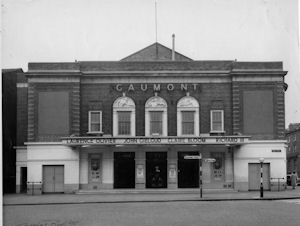 |
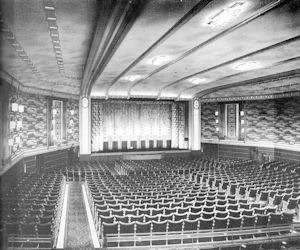 |
The Gaumont Palace opened on the corner of King Street and Trafalgar Road on Monday, 13th November 1933 by the Mayor of Wallasey, Henry J. Hall JP. The theatre was built on the former site of the Lyceum located which had been destroyed by a fire in December 1932 and thereafter demolished. The first showing at the Gaumont was 'I Was A Spy' starring Conrad Veidt (1893-1943), Madeleine Carroll (1906-1987) and Herbert Marshall (1890-1966). Also featuring on the opening programme was Laurel and Hardy's 'Towed In A Hole' and a Mickey Mouse cartoon, 'Building A Building'. Matinees were daily at 2.30 pm and evening performances continuous from 6.15 pm. Admission prices were 1/3. 9d and 7d with reductions for the matinees.
The new building was designed by Mr.W.E. Trent in a classical style. The outward appearance was described as being restrained and dignified. It relied for effect on a few decorative details to contrast with the simplicity of the main fabric of the building. Thus, the exterior frontage of the cinema was of brick and artificial stone dressing, brilliantly illuminated and with a well-lit canopy, stretching across the three main entrances. Outside, above the large three windows were three semi-circular carvings depicting the film production, being the work of Frank Barnes of Gaumont-British Corporation.
The entrance hall of the theatre was lined with horizontal panels of French and Italian walnut surmounted by frieze of grained 'curly' birch'. The hall was lit with three large diamond-shaped light fittings and there was a long continuous row of tubular light fittings at each end of the lounge that ran along the centre of the ceiling.
The seating capacity of the auditorium was 1,209 which composed of 777 seats in the stalls and 432 seats on the raised platform at the rear of the hall. There was no balcony because it was discovered that 'rights of light' of adjoining premises would of been infringed upon so in order to overcome the problem the design of the auditorium was that of a stadium style with a stepped circle area at the rear. The lighting in the auditorium was provided by wall lights, each comprising columns of glass cylinders mounted in trios on vermilion rods which projected at an angle beyond the face of the walls to provide a necessary contrasting member to the general horizontality of the decorative scheme. The main lighting for the auditorium came from two rows of coloured lighting and eight large ceiling-fittings. There was further lighting above the proscenium as well as two-colour lighting. A rich coloured modern tapestry which was manufactured in Birkenhead covered the main upper-part of the walls which served both as a decorative feature as well as an acoustical aid.
The Gaumont had a staff of thirty and was headed by the former manager of the Trocadero in Liverpool, Fred J. Smidmore. However, he did not remain long and a year later left and was replaced by Henry Gurney who was a former manager of the Lyceum. In keeping with many up-market cinemas all the staff wore uniforms. The usherettes were dressed in dark red with navy facing and collars, whilst the doormen wore black uniforms with gold braid and white gloves.
Commencing from 26th December 1937 saw the introduction of Sunday concerts during the winter season. Many local groups appeared as well as those employed by the Gaumont British operated ballrooms in the north west of England. The Sunday concerts were once nightly and were resumed again, after a break during the summer season, in September 1938, and then again from October 1939.
Sunday cinemas was introduced to Wallasey which saw an end to stage concerts but the theatre continued to be on of Wallasey's most popular venues for entertainment fight up into the early 1950's. A new wide screen was installed in October 1954 and in December of that year the first CinemaScope Film was screened - 'The Black Shield of Falworth' starring Tony Curtis (1925-2010) and his then wife Janet Leigh (1927-2004). However, these innovations did nothing to halt the then declining attendances and in 1967 the theatre was one of those sold by Rank to the expanding Classic circuit. The theatre was then re-named as Classic but a further decline in attendances caused the new owners to introduce bingo for a short period in early 1969 with films being shown on a Sunday and at the Saturday morning children's show. The stage was extended forward so to facilitate bingo and the floodlights were removed. By April 1969 there was a reversion back to full-time Cinema programmes. In September 1973 the owners of the nearby Royal Bingo Club agreed to take over the Classic providing that a new bingo licence could be obtained (the former licence having lapsed in the meantime). There was much opposition and the application to the council was turned down.
In 19th October 1974 Unit Four Cinemas of Burnley took over the cinema who offered to show 300% of more choices in films. Within weeks of the take over, Unit Four set about splitting the auditorium into four separate cinemas. The stalls area was dub-divided into three cinemas with a new projection room sited above the aisle that formerly divided the stalls from the circle. The fourth cinema was in the circle area using the original projection facilities. In 1979 two additional screens screens were added, making six cinemas in the complex. The original lounge housed the a licensed bar and facilities for advance bookings were provided.
Taken over by Apollo Leisure in 1994 it was re-named Apollo 6 Cinemas and these continued to operate until closure came in 2000. The building was left empty until 2005 when it was demolished and a block of flats built on the site.
Old Court House Picturedome
(Kinema/Kings/Picture House/Continental)
The Old Court House Picturedome was in Liscard Road and began life as a Police Station, being built in 1845. The building was then converted into a 400 seater cinema and opened on Saturday 31st January, 1914, under the management of Mr. James Burt. The opening feature included 'Her Majesty the Little Queen'
Performances began each evening at 6.30 pm and 10.30 pm with matinees at 3.00 pm on Wednesday and Saturdays. On Mondays and Wednesdays the programmes were changed twice weekly. Ticket prices were 3d for the Pit Stalls, 6d in the Stalls and 9d for the Balcony.
On the outside of the theatre wide, steep steps led to a small entrance hall with its central paybox and a pair of steep staircases on either side provided access to the balcony. Inside the theatre the auditorium was square shaped with a lofty ceiling and a silver screen was raised high up on the end of the wall. The electric generator was housed in the former basement which had been the prison cells.
Between the 13th June 1914 and the autumn the Old Court closed, in part due to the drab design of the building but on 14th November of that year the newly decorated cinema reopened as the Kinema under the management of C.W Harrison. The opening film was the short comedy 'Partners in Crime' starring Billie Ritchie (1878-1921) and Fatty Voss (1886-1917) with piano accompaniments were provided by George Briscoe.
By the early 1920s the cinema was renamed Kings and in 1931 talkies were being shown. Throughout the 1930s the Kings underwent several changes in management and refurbishments. One of the renovations was in 1932 with the introduction of twin seats for courting couples, whilst in 1934 saw the installation of a larger screen and another decoration scheme.
Bomb damage during the air-raids caused the flat roof to leak and by 1941 the overall condition of the building was dire. Further problems occurred when the manager, Arthur Bell, misused the night takings and spent it in the nearby public house. With the bills not being paid the electricity supply to the cinema was disconnected. More problems arised with the film renters over the supply of films which resulted in one film, 'Secrets of F.P.I' (1933), which was originally booked for three days having an extended run of three weeks. The management claimed the film was "Retained by public demand" but the evidence of dwindling attendances suggested otherwise. In March 1942 the licensing authority refused to renew Mr. Bell's licence and a new lessee took control. Though Mr. Bell brought action for damages against the owners the case was dismissed when it was shown that he failed to maintain the building in a good state of repair, records showing non-payment of bills and refusal of the renters to supply any films.
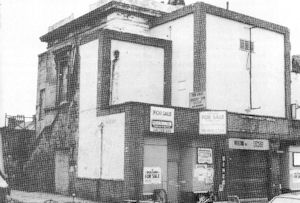 Gordon Howart became the new manager in May 1946 and rechristened the cinema The Picture House. The cinema was again redecorated and for a period amateur variety shows supplemented the film programme on Tuesday and Friday evenings. In 1947 the cinema was owned by Leslie Blond who went on in 1951 to own the Phoenix in Wallasey Village and 10 years later to control the Hope Hall Cinema in Liverpool (later demolished and where Everyman Theatre is today). In April 1949 Blond introduced a trial season of continental films which proved successful so he embarked on mainly showing foreign films at what was by then described as The Continental Picture House (the word Picture House were eventually dropped). The Continental was Merseyside's only commercial cinema specialising in foreign films up to 1963.
Gordon Howart became the new manager in May 1946 and rechristened the cinema The Picture House. The cinema was again redecorated and for a period amateur variety shows supplemented the film programme on Tuesday and Friday evenings. In 1947 the cinema was owned by Leslie Blond who went on in 1951 to own the Phoenix in Wallasey Village and 10 years later to control the Hope Hall Cinema in Liverpool (later demolished and where Everyman Theatre is today). In April 1949 Blond introduced a trial season of continental films which proved successful so he embarked on mainly showing foreign films at what was by then described as The Continental Picture House (the word Picture House were eventually dropped). The Continental was Merseyside's only commercial cinema specialising in foreign films up to 1963.
On 2nd November 1963 the cinema closed for the final time with a double feature programme, 'The Quare Fellow' with Patrick McGoohan (1928-2009) and Sylvia Simms (1916-1992) plus 'Battle of the Sexes' with Peter Sellers (1925-1980). The building was subsequently used for a time as a bingo hall but was finally demolished in 1986 and new properties built on the site.
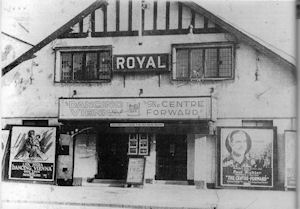 |
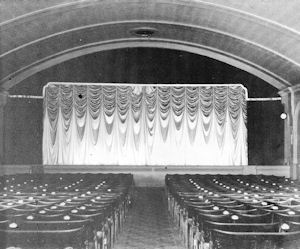 |
Situated on King Street, the Royal was once a building used as a Drill Hall for the 3rd Cheshire Riles, being built around 1865, then converted into a cinema by Wallasey Cinema Ltd, with Mr. W.D Burrows as Managing Director. The Royal opened on 4th November, 1912 and had seating for 850 patrons. Performances were continuous from 6.30 pm to 10.45 pm and matinees were on Saturdays. Admission was 2d, 3d and 6d. The opening programme consisted of six films which consisted of 'The Wheel of Destruction', 'The Church Round The Corner', 'Jenkin's Hydraulics', 'Wanted - A Divorce', 'Red Ruby's Redemption', and the Western drama, 'In Swift Waters'.
Inside the Royal was a wide auditorium which contained a raked floor which provided good views of the screen from all the seats. There was no balcony which helped to ventilation of the building which improved the quality of the atmosphere. The exterior design of the building had a simple white-painted facade and was partially timbered. There was two sets of leaded light windows which had an illuminated glass sign displaying the name of the house. Entrance from the street was by two pairs of Georgian glass panelled doors which led into a small foyer where the pay box was centrally located.
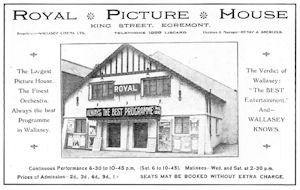 |
On 20th January, 1913 the Royal began a new innovation in the screening of a serial film in eight installations called 'Our Navy', which was shown over a period of four weeks. On 26th June 1929, the Royal became the first cinema in Wallasey to show talking pictures. The first programme featured a short one-reeler of J.H. Squire's 'Celeste Octet'. A short silent sketch of Charles Dicken's 'Bleak House' starring the famous English actor, Bransby Williams (1870-1961) and the London Ceremony of the Trooping of the Colour was also shown. The Royal Orchestra provided accompaniment for these mixed programmes of talkie and silent shorts.
In 1931 the Royal had another major modification with the construction of a verandah and on 24th February 1934, at great expense, an upgraded British Talking Pictures (BTP) sound equipment was installed. The new apparatus gave extended frequency range to enhance the quality of speech and music in terms of tone and apparent power output.
In September 1935, following the suicide of the manager, Alfred Brewer, the former chief projectionist Hector McQueen took over. A year later David Forrester, Theatres Manager of Manchester, took over ownership. The cinema closed for a week to undergo refurbishment which included a complete redecoration, new seats, curtains and lighting installed. The Royal reopened on 21st September and the following year Mr. McQueen installed Rediffusion sound equipment which enabled BBC programmes to be played to the cinema audience for half an hour to the commencement of film shows.
Special Sunday concerts were introduced from 24th October, 1937 for the winter season. Jack Leigh and his original Embassy Band were the first to perform which also included fifteen other talented performers, including Patrizov, formerly of the Capitol, Liscard. Another manager. A.E Drennen, held talent contests on Sundays from September 1938 and photo competitions were also a feature. Another gimmick was introduced in January 1939 which had an attendant with a mirror catching the spot light and shining the reflected light on lucky prize winners. These prizes ranged from towels to table-cloths, and sausages to cwt. of coal.
In 1948 the proprietors of the the New Brighton Palace in New Brighton, Whilma Wilkie and Henry Neck, purchased the premises and completely gutted out and upgraded the cinema at a cost of £10,000 which included renewing the ceiling, floor, carpet, heating and seats which now had a capacity of 872. Also the screen was moved backwards so that the stage could be used. The cinema reopened on the 13th December with Mr. T. Foster as the new manager.
At the end of 1954 a large 30ft CinemaScope screen was installed and stereophonic sound was introduced - the first cinema in Wallasey to be so equipped. The first film to be shown on the new screen was 'The Robe which was screened on the 6th December, 1954 and starred Richard Burton (1925-1984) and Jean Simmons (1929-2010). The Royal closed for a while in 1958 and re-opened in November of that year, with Mr G.A Taylor as Director who had been one-time manager of the Liscard Picture Palace in Seaview Road. To attract audiences the price of admission were reduced and a wider variety of films were shown but a few years later the proprietor, Mr. Albert Johnson, was forced to close the cinema for the last time on 28th January 1967. The final programme was a double horror feature which comprised of 'The Day of the Triffids' and 'King Kong vs Godzilla'. The building was taken over for a time as a bingo hall and today is a snooker hall.
Moreton |
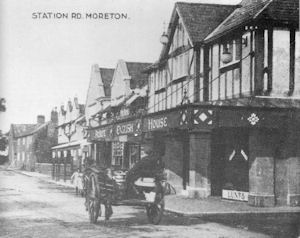 The cinema officially opened on 30th April 1921 with Mr. W.W. Wright as manager and the first film to be shown in the 850 seat cinema was 'Wit Wins'. The cost of seats ranged from 9d in the front stalls, 1/- for reserved stalls, and 1/7 in the balcony. There were two performances each evening at 6.40 and 8.40 with matinees at 2.45 pm.
The cinema officially opened on 30th April 1921 with Mr. W.W. Wright as manager and the first film to be shown in the 850 seat cinema was 'Wit Wins'. The cost of seats ranged from 9d in the front stalls, 1/- for reserved stalls, and 1/7 in the balcony. There were two performances each evening at 6.40 and 8.40 with matinees at 2.45 pm.
Designed by the well-known theatre architect, A.E. Shennan, the Moreton Picture House was situated on 16 Station Road (later renamed Pasture Road), Moreton, for Cheshire Picture Halls. The theatre was cheaply built and adopted a Tudor style with half timbered frontage with a canopy supported by two piers between which were two shops. Inside the seats were upholstered in rich crimson and blue velvet. Access to the balcony was from the entrance hall via two marble staircases balustraded with hard-wrought iron work.
Moreton at this time was largely unbuilt so the appeal of the cinema was targeted mainly to those from the surrounding area who enjoyed a cycle trip and would enjoy a break by watching a film. In fact the cinema offered free storage of bicycles.
By 1937 Cheshire Picture Halls had become part of the S.M. Super Cinemas circuit until this company was taken over by Essoldo chain in 1954.
On 28th March 1964 Moreton Picture House closed with a showing of 'Flight of the White Stallion' starring Robert Taylor (1911-1969) and Lilli Palmer (1914-1986). Today the building is still in use as a bingo hall.
Featured sites
- Non Gamstop Casinos
- Casino Not On Gamstop
- UK Casinos Not On Gamstop
- Non Gamstop Casinos UK
- Sites Not On Gamstop
- Sites Not On Gamstop
- Casinos Not On Gamstop
- Casinos Not On Gamstop
- Casinos Not On Gamstop
- Non Gamstop Casino UK
- Casinos Not On Gamstop
- Non Gamstop Casino
- UK Online Casinos Not On Gamstop
- UK Online Casinos Not On Gamstop
- Non Gamstop Casinos
- Casino Sites Not On Gamstop
- Casinos Not On Gamstop
- Casinos Not On Gamstop
- Best Betting Sites
- Casinos Not On Gamstop
- Gambling Sites Not On Gamstop
- Betting Sites That Are Not On Gamstop
- Non Gamstop Casinos UK
- UK Online Casinos Not On Gamstop